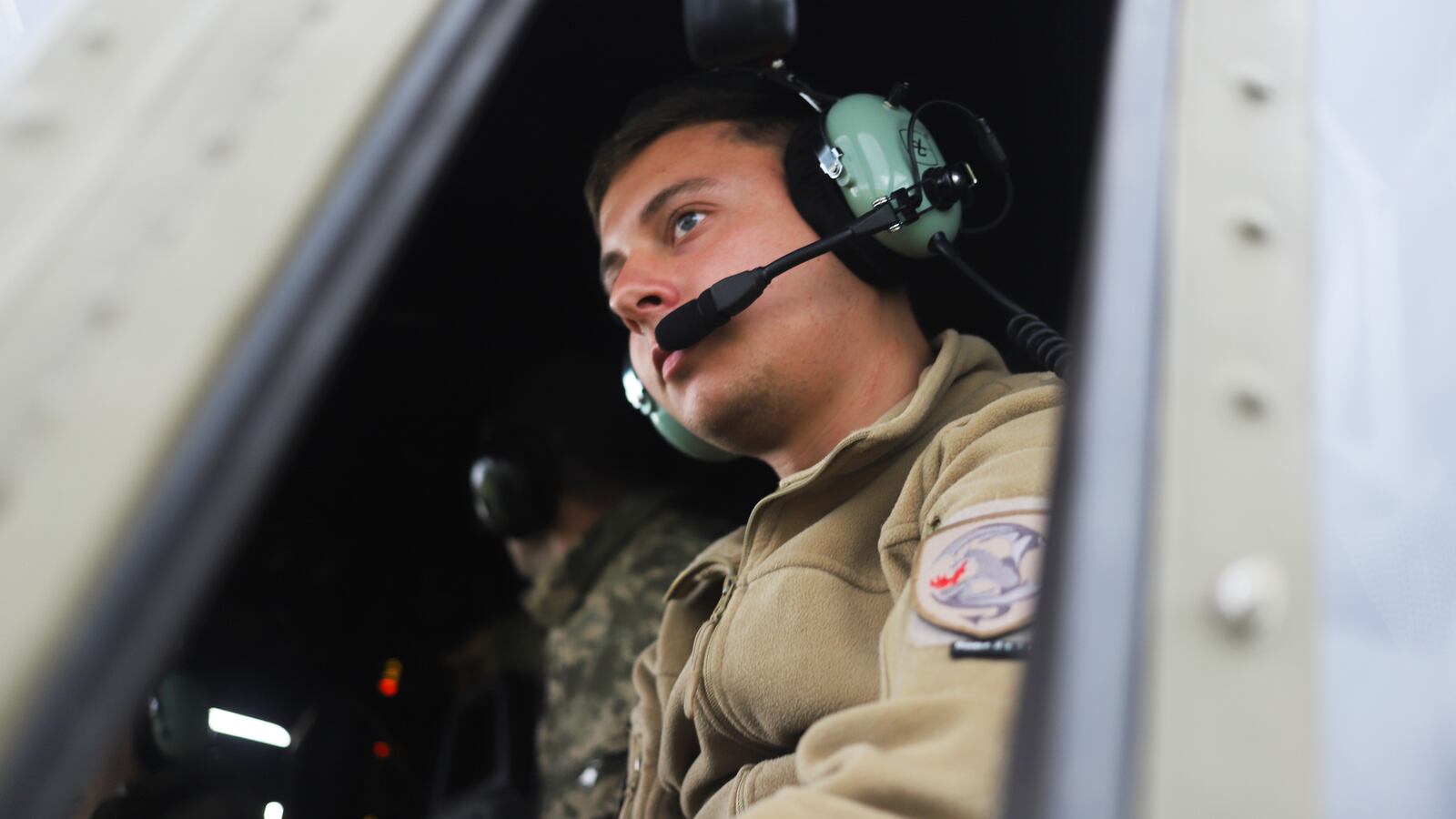LVIV OBLAST, Ukraine—Ihor and Andriy’s helicopters flew under cover of dawn and fog deep into enemy territory. “We came from the sea to avoid being spotted by Russian defenses, flying at altitudes of less than 10 meters… it is extremely dangerous because you can run into power lines or trees,” Andriy told The Daily Beast while puffing on a cigarette in a training ground near the city of Lviv. Ukrainian servicemen generally do not give last names for security reasons. Despite being only 22, Andriy has already flown more than 30 secret missions in the world’s most dangerous airspace. “We were flying into Mariupol at the height of the siege [in April last year],” he said.
Their mission was considered impossibly risky when it was first proposed and—perhaps because it was so audacious and unexpected—it was working. For weeks, the Russians had surrounded the port city of Mariupol, trapping resolute defensive forces in the Azovstal steelworks. With no way in or out of the city by land, the only way to resupply the defenders was by air, a death-defying infiltration that required them to get in and out across 70 miles of Russian-controlled territory.
The exhausted soldiers were astonished when the pilots landed, having expected to be trapped with no possibility of escape or resupply. In a trip lasting under an hour, they unloaded supplies of food and ammunition, and picked up wounded soldiers for extraction to free Ukrainian territory.

The Russians soon realized what was happening—several helicopters on later missions to Azovstal were shot down, and the missions were canceled. Ihor and Andriy’s missions were a reminder of Ukrainian heroism in what seemed like impossible circumstances, and the country’s determination not to leave its people behind.
These helicopters, many of them rickety-looking decades-old designs that date from Soviet times, were not supposed to still be flying. A Russian missile barrage on the first day had smashed into Ukraine’s air bases throughout the country, putting many of the newer choppers out of commission. But the pilots had been listening to American pleading, and at the last moment had moved their best assets out of danger. A year and a half into the war, they are still fighting the Russians for control of the sky.
Compared to the ground war, with its well-filmed tank battles, artillery barrages and desperate trench assaults, the air war in Ukraine has been shrouded in mystery. The Daily Beast received an exclusive opportunity to visit Ukraine’s 10th Army Aviation Brigade at one of their secret training locations in the west of Ukraine.

About 20 horses were grazing in a paddock when the faint whirring of helicopter blades could first be heard in the distance. Initially no bigger than the head of a pin, a helicopter appeared on the horizon, the sound of its blades slicing through the air getting progressively louder as it approached. The aircraft, a Soviet-made Mil Mi-8, with sides painted in the colors of the Ukrainian flag, remained stationary over the field for a few moments, before landing with a deafening din. The horses, unfazed, calmly observed the scene. The helicopter was a model designed in 1967. It had been modified with extra armor but lacked the early warning systems on more modern aircraft. Still, in lieu of modern Western equipment, the pilots here work with what they have. For the first time in 2014 during the Donbas war, the brigade’s helicopters took part in the first battle for Donetsk airport, which allowed the Ukrainian Army to regain temporary control of it in May 2014 from Russian-backed separatists.
Because the Russians never managed to secure air superiority over Ukraine, helicopters and jets are still used by both sides but Andriy has disappointing news for fans of Top Gun style dog fights, saying that aviation is used to support ground forces, and that aerial dogfights are vanishingly rare.
Due to the presence of air defense systems on both sides, helicopters are forced to fly fast and low to avoid radar detection. He pulls out his phone to show a video of his helicopter whizzing towards the ground somewhere in the battlefields of eastern Ukraine, before raising its nose to deliver a barrage of dozens of rockets at the waiting Russian trench, then pulling off a stunning midair turn to fly back to safety.
For all their heroism, the Ukrainians remain technologically outmatched by the Russians in the air. The Russians have a beast of their own, the KA-52 “Alligator” helicopters that became notorious for harrying advancing Ukrainian ground forces at the start of the counter-offensive in June. Ukrainians called them “Putin’s vultures” because of the carnage they inflicted on advancing forces.
“As Ukrainian forces continue major offensive operations in Zaporizhzhia Oblast, one of the single most influential Russian weapon systems in the sector is the Ka-52 HOKUM attack helicopter,” the British Ministry of Defence said in an update shortly after the counter-offensive campaign ran into trouble.

“Russia has highly likely lost around 40 Ka-52s since the invasion, but the type has also imposed a heavy cost on Ukraine… Russia has highly likely augmented the force in the south with at least a small number of brand new, Ka-52M variants: a heavily modified aircraft, informed by lessons from Russia’s experience in Syria.”
The U.K. MoD continued by noting that the Ukrainians had very little idea how to counter these threats. “Another key improvement to the Ka-52 fleet is the integration of a new anti-tank missile, the LMUR, which has a range of approximately 15 km. Ka-52 crews have been quick to exploit opportunities to launch these weapons beyond the range of Ukrainian air defenses.”
With a range of around 5 miles, the Russian Ka-52s can stay in relatively safe airspace out of range of Ukraine’s short-range air-defense systems, while Ukraine needs its best anti-air assets to stop Russian bombardments of its cities.
“You see what we can do with those, so imagine what we could accomplish with American aircraft, or French aircraft,” said one of the pilots, before listing the weapons and ammunition that he said Ukraine desperately needs: American Vipers, Venoms and the feared Black Hawk helicopter gunships, and above all, long-range missiles allowing them to strike Russian positions without being detected. Interrupting our conversation, the officer receives a call from the captain: the crew must go back on the mission. There was hardly any respite for these pilots who, after greeting us, flew away and disappeared on the horizon.

The next morning, we saw Russian Telegram channels in shock, as Ukrainian helicopters had managed a surprise assault on Russian positions in the Zaporizhzhia region, supposedly well covered by Russian air defense. “The helicopters flew by freely. Where did they come from?” one Russian military blogger fumed.
“I don’t know. But they were seen in Robotyne, flying west towards Kopani. They completed their mission and then headed north… This is already the second documented case of such a maneuver by the Ukrainian Armed Forces.”
Ukraine’s helicopter pilots are tight-lipped about their missions, but we wondered whether the men we had just met had pulled off yet another miracle raid.







